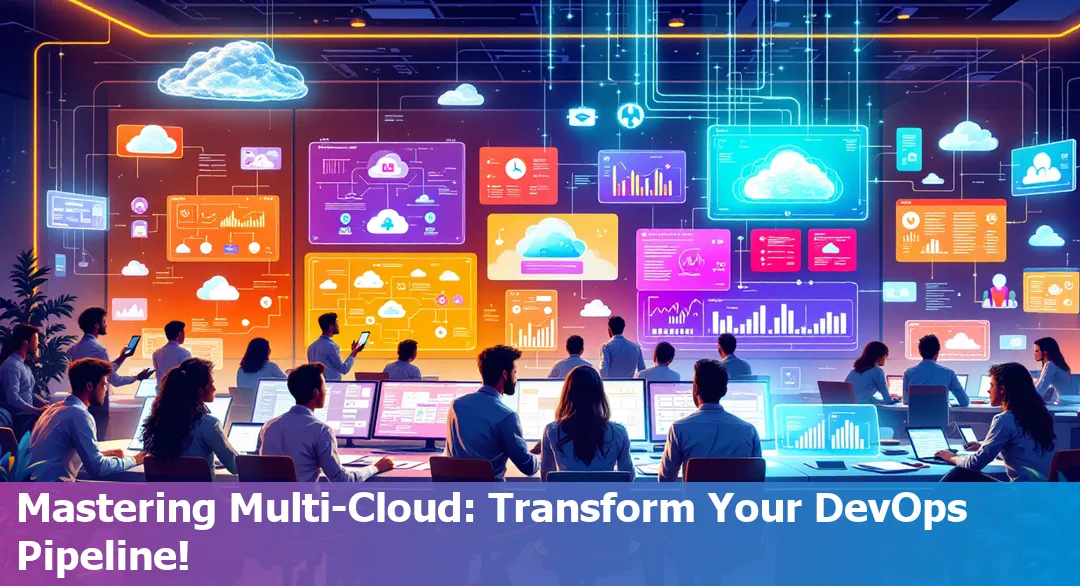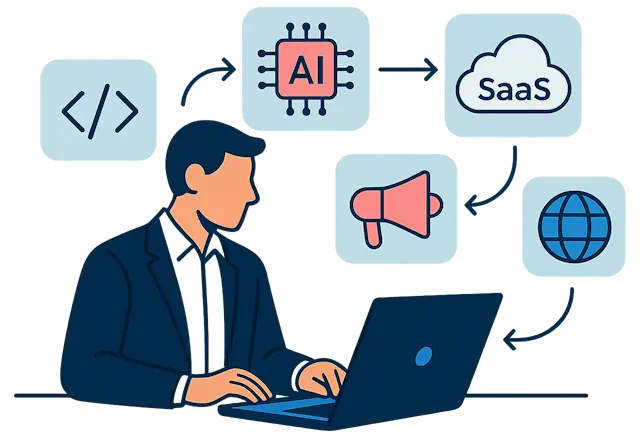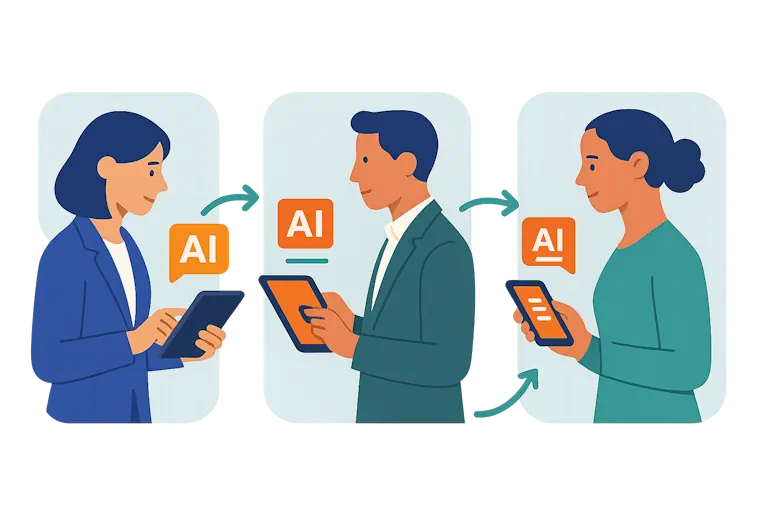DevOps Pipelines for Multi-Cloud Environments: Challenges and Solutions in 2025
Last Updated: February 24th 2025

Too Long; Didn't Read:
By 2025, DevOps pipelines have become crucial for managing multi-cloud environments, as 92% of companies utilize multiple clouds. Key challenges include complexity, cost management, and security, yet solutions like container orchestration, automation, and AI-driven optimization are significantly enhancing efficiency and reducing operational costs by up to 26%. Integrating advanced security measures and seamless tool compatibility is essential, with successful implementations showing 65% better efficiency. Multi-cloud strategies deliver a 55% ROI, outperforming single-cloud approaches. As the DevOps market grows at a 20% CAGR, mastering these technologies is pivotal for future-ready tech operations.
DevOps pipelines have totally transformed the tech landscape in 2025, becoming super important for handling multiple cloud environments. These automated workflows make it incredibly easy to move code from development to deployment, letting teams work together smoothly across different cloud platforms.
The stats are mind-blowing - 92% of companies are now using multiple clouds, and honestly, it makes perfect sense. Multi-cloud strategies give businesses the freedom to switch between providers and protect themselves from getting stuck with just one vendor.
It's pretty cool how modern DevOps pipelines can handle everything automatically - from testing code to deploying it across different cloud platforms.
The best part is how these systems can scale up or down instantly, depending on what you need. Right now, businesses are dealing with some real challenges, like keeping everything connected and watching their budget, but the benefits are totally worth it.
If you're planning to work in tech, understanding how to manage these multi-cloud pipelines is going to be essential - they're basically the future of how we'll build and run software.
Table of Contents
- The Rising Importance of Multi-Cloud in 2025
- Common Challenges in Multi-Cloud DevOps
- Strategies for Building Resilient Multi-Cloud Pipelines
- Key Technologies Transforming DevOps
- Benefits and ROI of Multi-Cloud Approaches
- Emerging Trends and Future of DevOps in Multi-Cloud
- Frequently Asked Questions
Get insights into leading frameworks like Laravel and Flask and how they shape backend development strategies.
The Rising Importance of Multi-Cloud in 2025
(Up)Multi-cloud environments have become a game-changer in 2025, with enterprises getting super creative about how they handle their cloud strategies. Multi-cloud integration lets companies avoid getting stuck with just one provider, giving them the freedom to mix and match services based on what works best for their needs.
Recent stats show that 82% of businesses are seeing major improvements in their disaster recovery game thanks to this approach. Companies can use AWS for heavy computing tasks while tapping into Google Cloud for their AI projects - it's like having the best of all worlds!
Cloud flexibility and agility have become absolute must-haves for businesses trying to stay competitive.
Companies can now scale their resources up or down instantly, which is crucial when market demands change unexpectedly. The cost benefits are pretty impressive too - organizations are seeing significant savings by selecting the most cost-effective services for specific workloads.
AI and machine learning are making this even better by automatically optimizing resource allocation and predicting when and where additional capacity might be needed.
Security is a huge deal in multi-cloud setups, and it's getting more sophisticated by the day.
Multi-cloud security solutions now include real-time threat detection and automated compliance checks across all platforms.
Companies are implementing zero-trust security models and using advanced encryption to keep their data safe, no matter where it lives in the cloud. With regulatory requirements getting stricter globally, these security measures aren't just nice to have - they're essential for staying in business and maintaining customer trust.
Common Challenges in Multi-Cloud DevOps
(Up)In 2025, managing complexity within multi-cloud DevOps environments is seriously challenging because of the rapid innovation in cloud services and diverse APIs.
The integration process is getting more complex, with enterprises juggling multiple cloud platforms simultaneously. According to recent data, teams need to stay updated with constantly evolving APIs and service integrations, making it super hard to keep everything running smoothly.
This complexity definitely increases the chances of system failures and compatibility problems, which is why having solid management strategies is absolutely essential.
The security situation in multi-cloud setups is getting pretty intense.
Recent research shows that implementing Zero Trust Architecture across cloud environments is becoming standard practice, with real-time threat detection and automated responses being crucial for protection.
Companies are discovering that managing security across different platforms isn't just about having good tools - it's about creating a complete security strategy that works everywhere, all the time.
Managing costs across multiple clouds is honestly a massive headache.
Studies indicate that organizations are dealing with complex cost management issues that demand constant attention.
The latest data shows companies are saving around 26% on cloud expenses by optimizing workloads across different providers. Plus, there's this whole sustainability angle that's becoming super important - companies using green cloud initiatives are reporting up to 20% lower operating costs.
It's basically a win-win situation - good for the planet and good for the budget.
Bottom line: while multi-cloud strategies are definitely the future, successfully managing them requires dealing with these challenges head-on through smart solutions and constant adaptation.
Strategies for Building Resilient Multi-Cloud Pipelines
(Up)Building resilient multi-cloud pipelines in 2025 demands smart implementation of cloud-agnostic strategies that work seamlessly across AWS, Azure, and Google Cloud.
Recent studies on cloud-agnostic platforms show that organizations are increasingly focused on creating flexible infrastructures that prevent vendor lock-in while maintaining operational efficiency.
The integration of automation tools has become super important - we're talking about a seriously game-changing 50% reduction in manual tasks through Infrastructure as Code (IaC).
Modern cloud automation tools like Terraform, Ansible, and Kubernetes are absolutely crushing it when it comes to resource management and deployment automation.
Successful multi-cloud strategies are handling security.
Multi-cloud DevOps practices are now incorporating enhanced security protocols that go beyond basic authentication.
The latest data shows that implementing comprehensive security measures can slash unauthorized access attempts by more than 30% - that's huge for protecting sensitive data across different cloud environments.
Teams are getting really good at using monitoring tools like Prometheus and Datadog to keep track of everything happening across their clouds. These tools can predict potential issues before they become real problems.
The key to nailing multi-cloud pipelines comes down to four main things:
- Tools everywhere: Ensuring your tools work seamlessly across all platforms.
- Automate everything: Automating every possible aspect to increase efficiency.
- Security tight: Keeping security measures strong across environments.
- Awesome monitoring: Using advanced monitoring to predict and mitigate issues.
The most successful companies aren't just throwing tech at the problem - they're making sure their teams are totally on board and skilled up to handle these complex environments.
The results speak for themselves, with organizations reporting up to 65% better efficiency when they get all these pieces working together.
Key Technologies Transforming DevOps
(Up)Currently crushing the DevOps game in 2025, organizations are leveraging powerful tools to handle their multi-cloud setups. Spinnaker and Terraform have become the ultimate power duo, revolutionizing how we manage cloud infrastructure.
Spinnaker absolutely shines in continuous delivery, making it super easy to deploy across different cloud platforms without breaking a sweat. Meanwhile, Terraform's infrastructure-as-code capabilities let developers write and manage cloud resources like they're coding an app - totally genius for keeping everything consistent and automated.
The CI/CD scene is seriously next level with GitHub Actions leading the charge.
Modern DevOps teams are going all in on automation tools, making deployment as smooth as possible. What's really cool is how these tools can handle multiple cloud providers at once, which is exactly what we need in 2025.
Looking at the numbers, more teams than ever are jumping on the CI/CD bandwagon, and this stuff just works.
When it comes to keeping everything running smoothly and securely, the latest monitoring and security tools are totally changing the game.
Prometheus and Grafana give us real-time insights that make troubleshooting so much easier. Plus, with Zero Trust security becoming standard practice, we're seeing way fewer security headaches.
Think of it as having a super strict bouncer who checks everyone's ID, no matter who they claim to be.
Bottom line: these tech advances are making multi-cloud environments more reliable and secure than ever, which is exactly what businesses need to stay ahead in the digital space.
It's wild how far we've come, and honestly, it's just getting started.
Benefits and ROI of Multi-Cloud Approaches
(Up)Multi-cloud strategies are totally changing how businesses operate in 2025. Recent studies show that 98% of enterprises now use or plan to use multiple cloud providers, which is a massive jump from previous years.
Companies can pick and choose the best services from different providers without getting stuck with just one. According to current industry data, over 55% of organizations are actively using multiple public clouds, with 21% running operations across three or more providers.
The flexibility is honestly incredible - businesses can shift their workloads wherever they need them, whenever they need to. What's really interesting is how 82% of companies report better disaster recovery capabilities with multi-cloud setups.
Plus, organizations can save serious money by negotiating better deals between competing providers and only paying for what they actually use. The best part is that companies can access cutting-edge tech from different providers - like using one cloud for AI stuff and another for data storage.
With the right management strategy, businesses are seeing major improvements in performance and significantly lower operational costs. It's basically like having a Swiss Army knife of cloud services at your disposal, ready for whatever challenges come up.
Looking at the numbers, it's pretty obvious why so many businesses are making the switch - the ROI speaks for itself, with multi-cloud strategies showing 55% returns compared to 35% for single-cloud approaches.
This isn't just about having multiple options; it's about building a tech infrastructure that can handle whatever comes next.
Emerging Trends and Future of DevOps in Multi-Cloud
(Up)The DevOps landscape in 2025 is seriously next-level with AI and automation reshaping development practices across multi-cloud environments.
The stats are mind-blowing - the DevOps market is growing at a 20% CAGR from 2023 to 2032, and organizations using AI-powered DevOps are seeing deployment times cut in half.
Tools like Jenkins X and GitOps are making continuous integration super smooth, while DevSecOps practices are getting stronger to handle the 45% of data breaches happening in cloud environments.
Security isn't just an afterthought anymore - it's built right into everything we do.
The really cool part is how monitoring systems have evolved to catch problems before they even happen.
DataDog and New Relic are basically predicting the future, spotting potential issues hours or even days before they could cause problems. And with 80% of organizations now running DevOps, the push for multi-cloud strategies is huge.
Everyone's using container orchestration with Kubernetes and tools like Spinnaker to keep their apps running smoothly across different cloud platforms. The industry is moving fast, and AI is making everything more efficient - we're talking about 25% faster delivery cycles when teams use AI-driven DevOps strategies.
It's pretty incredible how these technologies are changing the game for software development.
Looking ahead, the focus is all about making these systems work together seamlessly.
Teams are implementing real-time monitoring, automated security checks, and smart scaling solutions that adjust automatically based on what's needed. With cloud exploitation cases up by 95% year-over-year, having strong security and efficient processes isn't just nice to have - it's absolutely essential for staying competitive in 2025.
Frequently Asked Questions
(Up)Why are multi-cloud environments important in 2025?
In 2025, multi-cloud environments are crucial as they offer businesses the flexibility to mix and match services from different cloud providers, avoiding vendor lock-in and enhancing disaster recovery capabilities. This strategy allows companies to utilize the best services available across platforms like AWS and Google Cloud, leading to improved operational efficiency and scalability.
What are the main challenges of managing multi-cloud DevOps environments?
The key challenges include managing the complexity of integrating multiple cloud platforms, evolving APIs, and service integrations. This increases the risk of system failures and compatibility issues. Additionally, security management across various platforms requires comprehensive strategies, including Zero Trust Architecture and real-time threat detection.
How are organizations optimizing costs in multi-cloud setups?
Organizations are saving approximately 26% on cloud expenses by optimizing workloads across different providers and adopting green cloud initiatives, which can reduce operating costs by up to 20%. This involves selecting cost-effective services for specific workloads and negotiating better deals from competing providers.
What technologies are transforming DevOps for multi-cloud environments?
Powerful tools like Spinnaker for continuous delivery, Terraform for infrastructure as code, and GitHub Actions for CI/CD are revolutionizing management across multi-cloud setups. These technologies facilitate consistent and automated management of infrastructure while maintaining security and operational efficiency.
What are emerging trends in DevOps for multi-cloud environments?
Emerging trends include the increased use of AI-powered DevOps, with tools like Jenkins X and GitOps enhancing integration and security. Organizations are seeing faster deployment cycles and using real-time monitoring with tools such as DataDog to predict and prevent issues. Security is integral, with automated checks and smart scaling solutions becoming essential to remain competitive.
Understand the impact of the Federal American Privacy Rights Act on backend security regulations next year.
AI and ML are taking the front seat in observability, driving significant advancements like AI/ML's role in telemetry analysis that redefine efficiency and accuracy.
Implement optimal coding practices for scalable Python REST APIs that can handle the demands of 2025.
Explore emerging players like Peewee and PonyORM and see how they're reshaping the ORM landscape.
Discover the role of enhanced libraries like TensorFlow and PyTorch in driving the next wave of machine learning applications in DevOps.
See how Async-first frameworks gaining popularity are shaping the future of backend development.
Uncover key trends, including multi-cloud and AI/ML applications, that are redefining container orchestration.
Stay ahead of the curve with emerging trends in backend strategies, including AI-driven automation and serverless architectures.
Ludo Fourrage
Founder and CEO
Ludovic (Ludo) Fourrage is an education industry veteran, named in 2017 as a Learning Technology Leader by Training Magazine. Before founding Nucamp, Ludo spent 18 years at Microsoft where he led innovation in the learning space. As the Senior Director of Digital Learning at this same company, Ludo led the development of the first of its kind 'YouTube for the Enterprise'. More recently, he delivered one of the most successful Corporate MOOC programs in partnership with top business schools and consulting organizations, i.e. INSEAD, Wharton, London Business School, and Accenture, to name a few. With the belief that the right education for everyone is an achievable goal, Ludo leads the nucamp team in the quest to make quality education accessible


